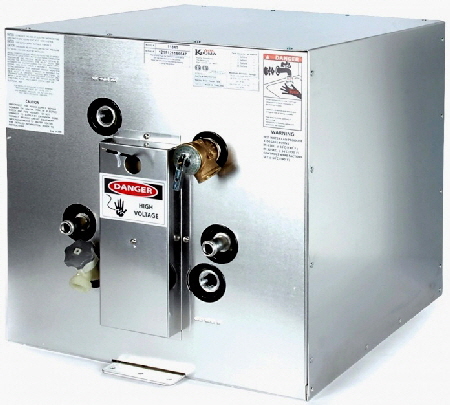 With 345 US gallons of fresh water my schooner Britannia has a larger than-average tankage. But then, the boat does have two fresh water flush heads in the bathrooms, each with a washbasin and shower and a pressure pump with a delivery as powerful as a house supply. The tanks are the popular square Kuuma model 11841. Originally the boat only had one 11 gallon tanak, but I installed a second one which enabled both showers to be operated at the same time
With 345 US gallons of fresh water my schooner Britannia has a larger than-average tankage. But then, the boat does have two fresh water flush heads in the bathrooms, each with a washbasin and shower and a pressure pump with a delivery as powerful as a house supply. The tanks are the popular square Kuuma model 11841. Originally the boat only had one 11 gallon tanak, but I installed a second one which enabled both showers to be operated at the same time
![]() Water is heated in two conventional ways; from a 120v 1500w 12.5amp immersion heater element inside the tanks, and by pumping very hot water from the engine through a coil inside the tank. Both methods can be used at the same time and when away from a dock Britannia’s 6.5 Kw generator was used to produce the 120 volts for the immersion heater. The engine operating temperature is 180F which is much too scoldingly hot to be used for washing or showering and must be cooled with cold water.
Water is heated in two conventional ways; from a 120v 1500w 12.5amp immersion heater element inside the tanks, and by pumping very hot water from the engine through a coil inside the tank. Both methods can be used at the same time and when away from a dock Britannia’s 6.5 Kw generator was used to produce the 120 volts for the immersion heater. The engine operating temperature is 180F which is much too scoldingly hot to be used for washing or showering and must be cooled with cold water.
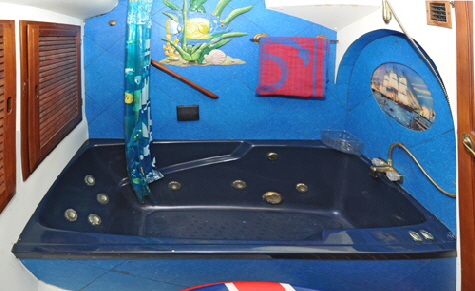 Not only does Britannia have the many facilities of a house it also has a full-size bathtub in the owner’s aft cabin en-suit bathroom. Many boats of Britannia's size have bathtubs, but mine is not just any old tub, it has eleven power jets all around the tub, making it a hot-tub spa
Not only does Britannia have the many facilities of a house it also has a full-size bathtub in the owner’s aft cabin en-suit bathroom. Many boats of Britannia's size have bathtubs, but mine is not just any old tub, it has eleven power jets all around the tub, making it a hot-tub spa
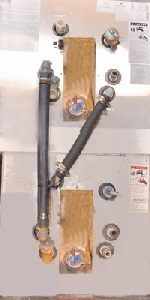 Britannia has two shore-power receptacles supplying two separate 120 volt distribution panels. This split the load of some of the higher electrical draws like the twin AC units and the washer/drier. Each emersion heater is wired separately through a 15am breaker on each panel. The advantage in wiring the two elements separately is that if one fails - as they often will after years of use - water could at least be heated in the other tank. Another advantage was to be able to disconnect the bottom tank heater by simply switching its breaker off when we didn’t need the full 22 gallons of hot water. To heat enough water for a 55 gallon bath, both tanks must be
Britannia has two shore-power receptacles supplying two separate 120 volt distribution panels. This split the load of some of the higher electrical draws like the twin AC units and the washer/drier. Each emersion heater is wired separately through a 15am breaker on each panel. The advantage in wiring the two elements separately is that if one fails - as they often will after years of use - water could at least be heated in the other tank. Another advantage was to be able to disconnect the bottom tank heater by simply switching its breaker off when we didn’t need the full 22 gallons of hot water. To heat enough water for a 55 gallon bath, both tanks must be 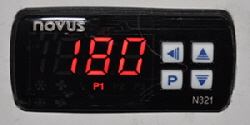 heated to much higher temperature than the 140F thermostat restriction on each tank. this is achieved using an adjustable thermocoupler temperature controller. This device regulates whatever temperature I want in both tanks through a double pole-double throw relay which enables one tank to be switched off if only one heater is needed.
heated to much higher temperature than the 140F thermostat restriction on each tank. this is achieved using an adjustable thermocoupler temperature controller. This device regulates whatever temperature I want in both tanks through a double pole-double throw relay which enables one tank to be switched off if only one heater is needed.
It takes three quarters of an hour for the thermocoupler controlled to heat the water to 180F in both tanks but If the engine is running at the same time the water is warmed up quicker. Both the hot and cold faucets are then opened and as the tub became nearly half full my rubber duck floating spa temperature gauge showed 175F, which is much, much too hot to even test by hand so cold water is run in until the temperature was reduced to 104F
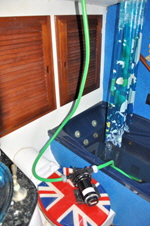
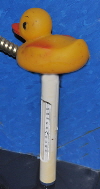 Pressing the button on the bath switches the pump on to activate all eleven powerful jets, The bath pipes and jets were insulated with foam when built, so the temperature does not drop much for a nice half hour relaxing soak. When we have been out on the water for a day and motor back to our berth the water is usually piping hot, solely through the engine calorific heat transfer, with enough hot water for a bath and virtually endless showers. When we stay on the boat for a weekend in the marina and we don’t plan on running a bath I adjust the controller to stop at just 100F on one tank only, which automatically maintains constant hot water for showers and dish-washing.
Pressing the button on the bath switches the pump on to activate all eleven powerful jets, The bath pipes and jets were insulated with foam when built, so the temperature does not drop much for a nice half hour relaxing soak. When we have been out on the water for a day and motor back to our berth the water is usually piping hot, solely through the engine calorific heat transfer, with enough hot water for a bath and virtually endless showers. When we stay on the boat for a weekend in the marina and we don’t plan on running a bath I adjust the controller to stop at just 100F on one tank only, which automatically maintains constant hot water for showers and dish-washing.
The bath is drained by simply placing my portable deck-wash in the bath and the discharge end hose passing through the portlight and over the side, that emptied the bath in 5-minutes flat!